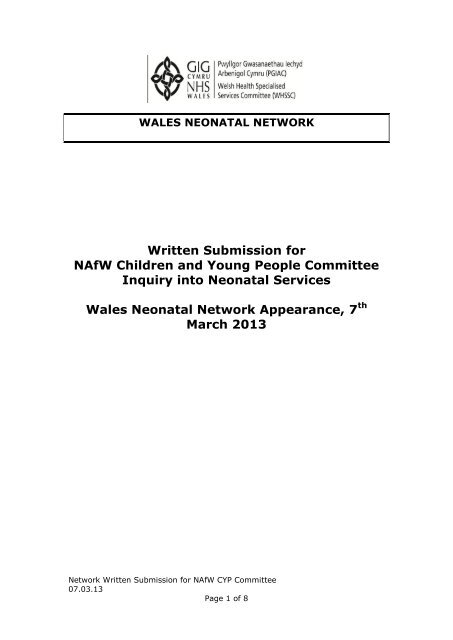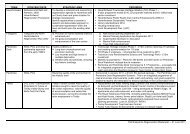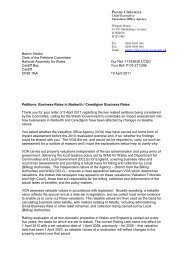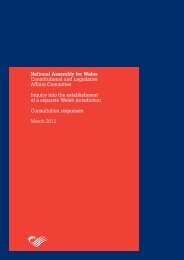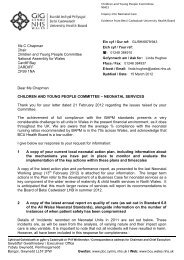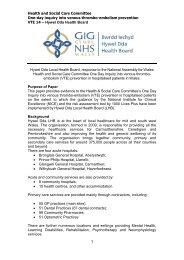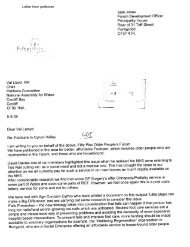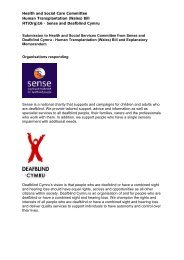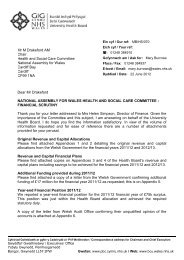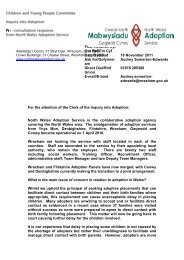CYP(4)-08-13 Paper 2 - Wales Neonatal Network - Senedd ...
CYP(4)-08-13 Paper 2 - Wales Neonatal Network - Senedd ...
CYP(4)-08-13 Paper 2 - Wales Neonatal Network - Senedd ...
Create successful ePaper yourself
Turn your PDF publications into a flip-book with our unique Google optimized e-Paper software.
WALES NEONATAL NETWORKWritten Submission forNAfW Children and Young People CommitteeInquiry into <strong>Neonatal</strong> Services<strong>Wales</strong> <strong>Neonatal</strong> <strong>Network</strong> Appearance, 7 thMarch 20<strong>13</strong><strong>Network</strong> Written Submission for NAfW <strong>CYP</strong> Committee07.03.<strong>13</strong>Page 1 of 8
Index1. Role of the <strong>Wales</strong> <strong>Neonatal</strong> <strong>Network</strong> 32. Capacity Review 2012 - Progress made byHealth Boards to implement the recommendations 43. Capacity Review 20<strong>13</strong> 64. References 8Appendix 1 9<strong>Network</strong> Written Submission for NAfW <strong>CYP</strong> Committee07.03.<strong>13</strong>Page 2 of 8
1. Role of the <strong>Wales</strong> <strong>Neonatal</strong> <strong>Network</strong>The seven Local Health Boards in <strong>Wales</strong> are responsible for ensuringthat plans are put in place to allow neonatal services in their area tomeet the All-<strong>Wales</strong> Standards. The purpose of the <strong>Wales</strong> <strong>Neonatal</strong><strong>Network</strong> Steering Group is to co-ordinate the approach across <strong>Wales</strong>and to ensure that the benefits of working collaboratively arerealised. The <strong>Wales</strong> <strong>Neonatal</strong> <strong>Network</strong> Steering Group is anAdvisory Group to the Welsh Health Specialised Services Committee(WHSSC) and advises the Joint Committee on issues regarding thedevelopment of neonatal services in <strong>Wales</strong>.The <strong>Network</strong> team undertook an initial review of neonatal carecapacity across <strong>Wales</strong> in October 2010. Local Health Boardsdeveloped individual local neonatal action plans in response and the<strong>Neonatal</strong> <strong>Network</strong> Steering Group has received a summary of theseplans. The Steering Group has representation from all Health Boardsacross as well as a other stakeholders including, Bliss, parents andWelsh Government.Since then, the <strong>Network</strong> has undertaken two more detailed reviewsof capacity and the outcome of these have been considered by the<strong>Neonatal</strong> <strong>Network</strong> Steering Group in January 2012 and February20<strong>13</strong>. Last year the <strong>Network</strong> team met with all Health Boards todiscuss their neonatal action plans and we are undertaking a similarround of visits in the next month.The <strong>Neonatal</strong> <strong>Network</strong> will continue to review capacity across <strong>Wales</strong>to ensure it meets demand now and in the future.The <strong>Neonatal</strong> <strong>Network</strong> monitors implementation of the All <strong>Wales</strong><strong>Neonatal</strong> Standards 1 at an individual Local Health Board level.Health Boards self assess themselves against a number of indicatorsand this is presented on a six monthly basis to the <strong>Neonatal</strong><strong>Network</strong> Steering Group and the WHSSC Joint Committee.Revised All <strong>Wales</strong> <strong>Neonatal</strong> Standards – 2 nd edition 2 have beenagreed by the Paediatric & Child Health National Service AdvisoryGroup (NSAG) in January 20<strong>13</strong>. These revised <strong>Wales</strong> Standardstake account of more recent UK guidance from British Association ofPerinatal Medicine (BAPM) 2010: Standards for Hospitals Providing<strong>Neonatal</strong> and High Dependency Care 3 and BLISS: Baby CharterAudit Tool 4 and provide more detailed information particularly inrelation to staffing levels in all relevant professions.<strong>Network</strong> Written Submission for NAfW <strong>CYP</strong> Committee07.03.<strong>13</strong>Page 3 of 8
2. Capacity Review 2012 - Progress made by Health Boardsto implement the recommendationsProgress made by all Health Boards to implement therecommendations made in the Capacity Review 2012 is outlinedbelow.Key messages include:Workforce The total establishment across <strong>Wales</strong> has increased by 29.34wte since July 2011. All Health Communities have seen anincrease in establishments of over 7%, apart from the SouthCentral, where there has been an actual reduction of -1.9%.46.29 additional wte nurses are now required across <strong>Wales</strong> tomeet the All <strong>Wales</strong> Standards. This can be comparedfavourably with the position in July 2011 when 82.64 wteadditional nurses were required for the “existing” cots.The South Central Health Community are the closest toachieving full compliance with the Standards based onnursing establishments, with 97.8% compliance. North <strong>Wales</strong>have the furthest to go with 83.1% compliance.Whilst Health Boards are all making progress with plans toreconfigure services, on the ground there is little evidence ofimmediate action to develop robust medical workforce plansto meet medical staffing standards for units in accordancewith BAPM, and the All <strong>Wales</strong> Standards – 2 nd Edition.<strong>Neonatal</strong> cots Two additional high dependency cots are being established inRoyal Glamorgan, Cwm Taf. This is in line with the <strong>Network</strong>’srecommendations to establish 3 additional cots to helpalleviate the pressure on critical care cots in the South CentralHealth Community.During 2012, a number of units revised their cot numbers totake on board recommendations in the Capacity ReviewJanuary 2012.o In February 2012, the intensive care cot at Nevill Hallwas re–designated for high dependency care.<strong>Network</strong> Written Submission for NAfW <strong>CYP</strong> Committee07.03.<strong>13</strong>Page 4 of 8
o In November 2012, 2 intensive care cots were moved toSingleton Hospital from Princess of <strong>Wales</strong> HospitalBridgend, allowing better use of this capacity that waspreviously being under utilised. Correspondingly, 4special care cots were moved to Princess of <strong>Wales</strong>Bridgend from Singleton.o In Ysbyty Glan Clwyd, cots were re-designated in July2012 to better reflect the activity taking place acrossthe three levels of care.Special care activity/occupancy All Health Boards have reported good progress inimplementing the <strong>Network</strong>’s Best Practice recommendations inrespect of reducing occupancy at low dependency care(special care). Overall there has been a marginal reduction in special careactivity in South <strong>Wales</strong> which is believed to reflect workundertaken by units to implement the <strong>Network</strong>’s lowdependency recommendations. In North <strong>Wales</strong>, there has been a major reduction in specialcare activity delivered. Again this could be attributed to workundertaken to implement the <strong>Network</strong>’s low dependencyrecommendations.<strong>Network</strong> Written Submission for NAfW <strong>CYP</strong> Committee07.03.<strong>13</strong>Page 5 of 8
3. Capacity Review 20<strong>13</strong>BackgroundThis review was presented to the <strong>Neonatal</strong> Steering Group on 7 thFebruary 20<strong>13</strong> and subsequently circulated to Health Boards,(attached Appendix 1). The <strong>Network</strong> is meeting with Health BoardExecutive teams in early March to discuss the latest findings andwill be supporting Health Boards in developing their revisedneonatal action plans.This is the 3 rd iteration of the <strong>Neonatal</strong> Capacity Review. It showsthe latest position on cot configurations and compliance withstandards for medical and nursing staff across <strong>Wales</strong>. It provides anoverview of neonatal activity during 2012 as well as discussion onsome of the factors affecting demand for neonatal care. Cotprojections and recommendations for Health Boards are included.Demand for neonatal careThere has been a major increase in demand for neonatal intensiveand high dependency care in South <strong>Wales</strong> between 2011 and 2012.The increase in activity experienced by units in South <strong>Wales</strong>appears to be attributable to the significant rise in the extremelypreterm birth-rate. These infants have a disproportionally highimpact on a Units workload both in terms of length of stay andacuity of care.Multiple pregnancies are known to be strongly associated withpreterm delivery and the overall proportion of multiple pregnanciesincreased in 2012 compared with 2011, in particular thoseassociated with extremely preterm delivery. This could help explaina significant part of the increased neonatal workload in 2012.In North <strong>Wales</strong> high dependency and intensive care activity hasremained fairly static between 2011 and 2012.The total number of live births in North <strong>Wales</strong> is continuing to riseand there have been year on year increases for 5 out of the last 6years. The number of extremely preterm live births is flattening offor perhaps even falling and the overall multiple pregnancy rate isnot increasing over time.Cot requirementsCot recommendations are based on: neonatal activity delivered between January–September2012, as reported via the Badgernet dataset<strong>Network</strong> Written Submission for NAfW <strong>CYP</strong> Committee07.03.<strong>13</strong>Page 6 of 8
on care days that were actually delivered for residents ofeach Health Community the BAPM 2011 Categories of Care 5 on cots required to meet 70% occupancy (IC and HD) and80% (SC).Previous projections have been based on the care days delivered byHealth Boards, within Health Communities and on the Categories ofCare, as defined in the BAPM Standards for Hospitals Providing<strong>Neonatal</strong> Intensive & High Dependency Care (second edition) andCategories of Babies Requiring <strong>Neonatal</strong> Care. 6Special careThere continues to be a shortfall of 18 special care cots required tomeet the 80% occupancy standards across all Health Communities.Health Boards should continue to look at ways to improve theprovision of low dependency care and have clear, measurable actionplans in place to take this work forward.In parts of the <strong>Network</strong> there is likely to be a need to invest inadditional special care capacity, even if all best practicerecommendations are fully implemented across <strong>Wales</strong>.Critical care - Intensive Care and High DependencyBased on current cot numbers and activity, 4 additional intensivecare cots and 3 additional high dependency cost are required inSouth <strong>Wales</strong> to meet average occupancy standards at 70%.Agreement is urgently needed to provide this additional capacity inthe short term.In North <strong>Wales</strong>, cot projections have been made based on theactivity delivered in 2012. However it should be noted that theamount of critical care delivered in the last year, is low in relation tothe birth population, and when compared to care days delivered inSouth <strong>Wales</strong>.<strong>Network</strong> Written Submission for NAfW <strong>CYP</strong> Committee07.03.<strong>13</strong>Page 7 of 8


